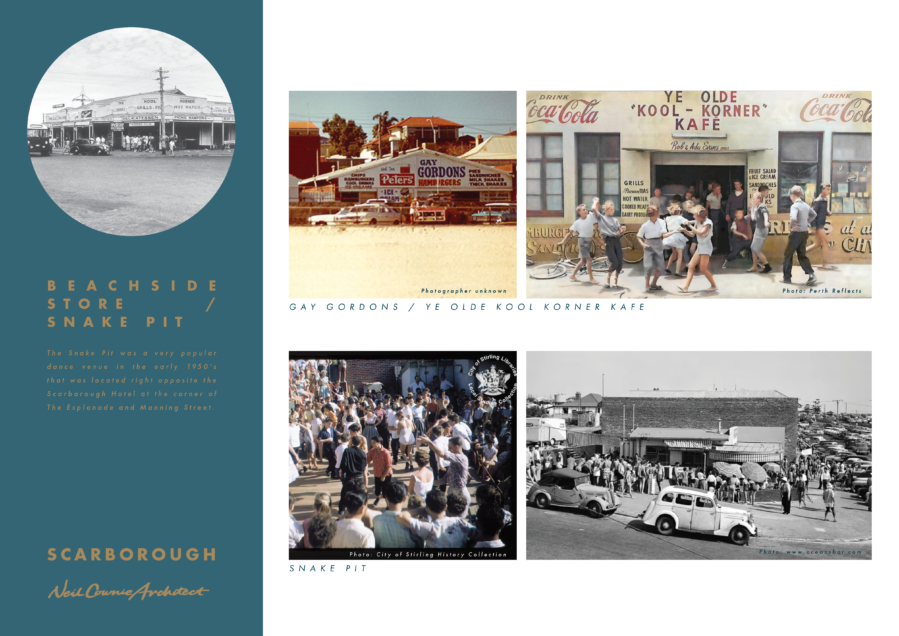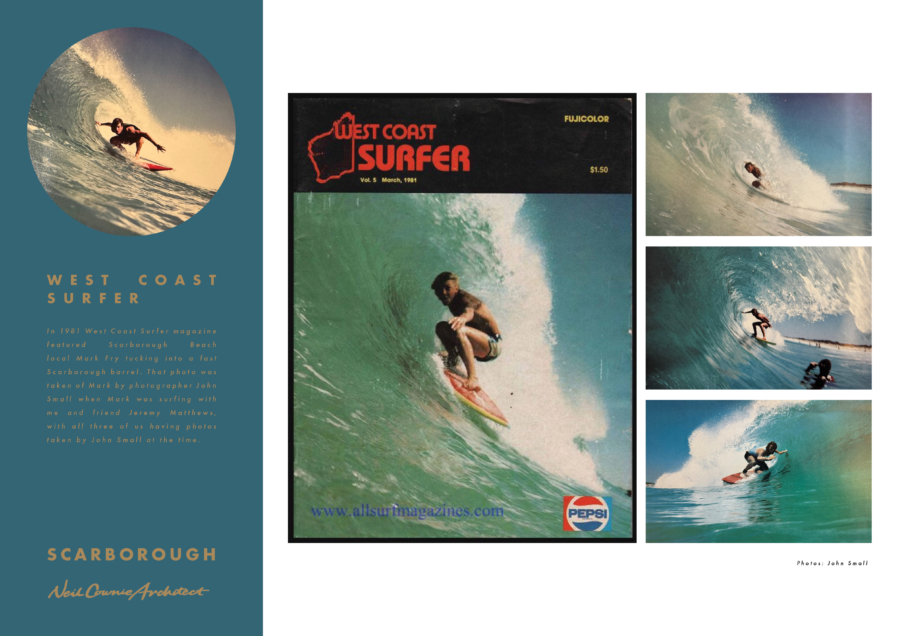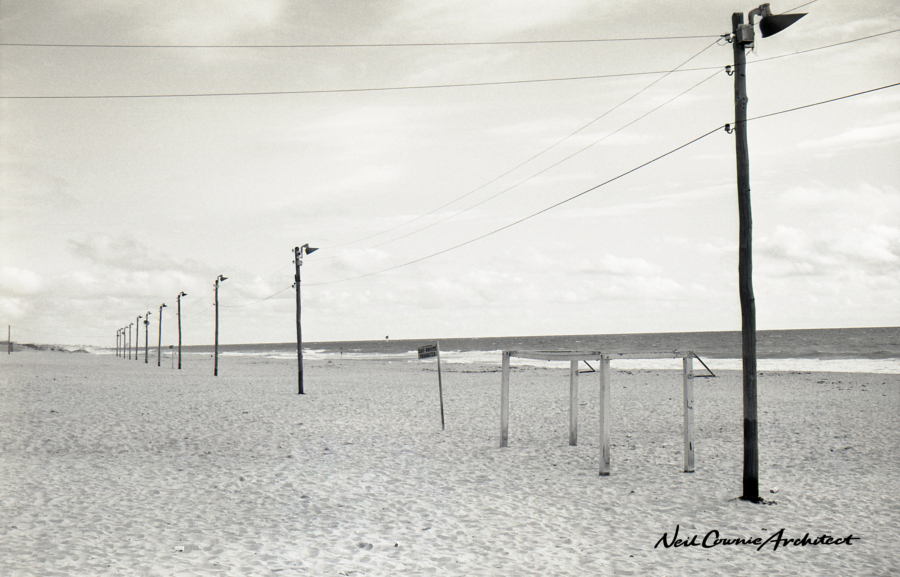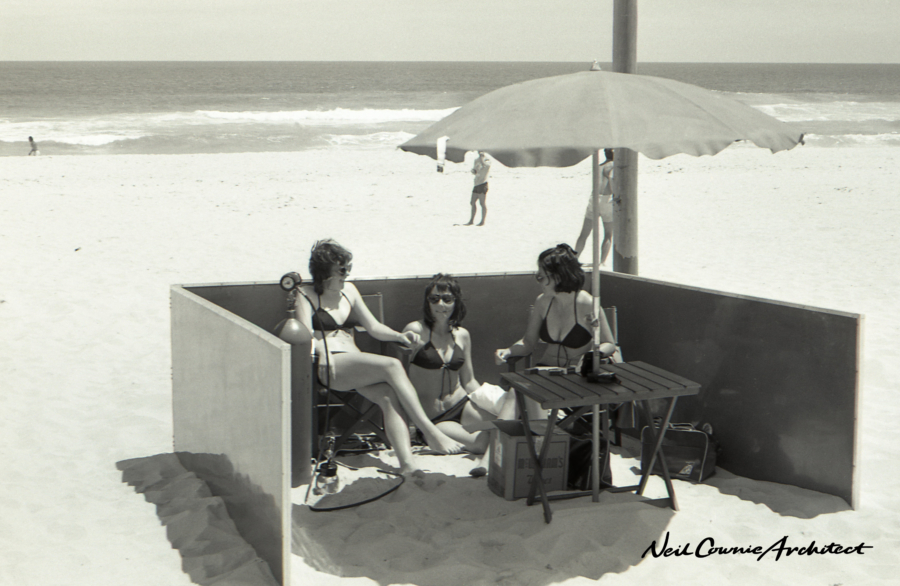Know Your Place
Scarborough

The first land parcel in Scarborough Beach was granted in 1869, continuing the dispossession of lands that had sustained the Nyoongar people for tens of thousands of years.
The Perth suburb of Scarborough was named after the English beach resort of the same name in North Yorkshire on the east coast of Great Britain. The name is believed to have first been used in 1892 by Patrick Callaghan, a Melbourne developer.
Post World War 2 the large-scaled development of the suburb of Scarborough took place with the street name in the area altered to take on names from the area of Yorkshire in the UK being the origin of the name Scarborough.
Behind the primary dune system in the low points between the old dune system that runs north / south parallel to the coastline you can today find the park areas of Abbett Park Reserve, Deanmore Square, Colin Ventnor Reserve and Butlers Reserve, all of which were likely to have been wetlands prior to European development of the area.
Robyn Gulliver in ‘Development or Dunes? The Long Struggle to Protect Perth’s Scarborough beach Coastal Reserve (2021)’ describes the community engagement of advocating for the protection of the dune system at Scarborough and Trigg beaches. ‘In Scarborough conservationists and local residents formed the Trigg Dune Heritage Group, enlisting well-known scientists and support from the Conservation Council of WA. Their efforts resulted in the identification of Trigg Bushland at the northern end of Scarborough Beach (known as the Trigg Regional Open Space) in 1981. With the ongoing threat of further development of the dune system, in 1989 conservationists succeed in securing 122 hectares of coastal bushland—but not the dunes—into a Class A Reserve’.
The carpark that existed between the beachfront shops and the beach sand would more often than not become one and the same as the dune-less unvegetated beach sand would blow every afternoon with the southwester all over the black bitumen car park. Following storms, the carpark was often trafficable with a layer of beach sand covering the carpark.

This image highlights local iconic places of interest, many of them just a memory.
Scarborough was first settled in 1869 with the first parcel of land granted to John Hughes. As the area was sandy, of little agricultural value and the coastal plain prone to strong winds, people didn’t really want to live here. In 1885 an Eastern States reporter referred to Scarborough as ‘The Manly of the West’ which sparked land developers to release the first subdivision for sale. Sales were still slow, and it wasn’t until the 1950s that Scarborough really took off as a place to live.

Reflecting the increasing number of visitors to and popularity of the area, October 1939 saw the opening of the “magnificent” Scarborough Hotel designed by architect W.G. Bennett, which was described as “one of the most modern of any resort hotels in the Commonwealth”.10 Scarborough Hotel was demolished in the late 1980s to make way for the Observation Rise residential development. (Source: Development WA – Scarborough Redevelopment Area Heritage Inventory’).

The Snake Pit was a very popular dance venue in the early 1950’s that was located right opposite the Scarborough Hotel at the corner of The Esplanade and Manning Street. The name ‘Snake Pit’ was apparently named after the snake-like dance moves that were popular at the time.

In an article on Australia’s beach culture Winfred Peppinck of Wandering Educators provides a colourful description of Scarborough beach’s ‘Snake Pit’: ‘At the “Snake Pit” on Scarborough Beach in Perth, Western Australia, the watchers were always plentiful, and the biggest cops were always there in numbers, as there was invariably trouble. “If you’re looking for trouble,” Elvis jeered from his RCA label record, “You came to the right place.” For the callow youths and beach-goers, watching these Vipers strut their stuff, there was always the accompanying thrill of feeling a modicum of rebellion and generational change. Bodgies and widgies, to say nothing of Bill Haley, Elvis, Little Richard, Buddy Holly and dozens of others, were condemned from the pulpits. We were being taken in by the Devil’s music and by that overtly sexual dancing and pelvic thrusts. Bodgies in collarless white tee shirts, stove pipe jeans, iridescent pink and lime green socks, black desert boots, jived with their Widgie women’.
By the 1970’s and early 1980’s the Scarborough Hotel was a cultural wonderland of bikies, surfers and beach goers all taking advantage of the rolling lawn of the beer garden with its view to the ocean.
The America’s Cup and Alan Bond brought major change to Scarborough Beach in 1986 when the buildings along the Esplanade were demolished (all but ‘Peters by the Sea’) along with the demolition of Scarborough Hotel to make way for high-rise buildings of Observation City Hotel (now Rendezvous Hotel) and subsequent apartments buildings, Observation Rise, were constructed.

Local surfer and industry great, Murray Smith made surfboards out of the garage to his house opposite Deanmore Square in Scarborough where Murray made my first custom board. Murray later moved his board making to a small warehouse in what is now the Framers Fresh building in Flynn Street, Wembley. WA surfing legend Murray ‘Muzz’ Smith won numerous WA State Surfing Titles through the 60s & 70s & an Australian Masters Title in 1980. He also established a reputation as a talented surfboard shaper and in 2014 was made a Life Member of Surfing WA for his contribution to WA surfing.
In 1981 West Coast Surfer magazine featured Scarborough Beach local Mark Fry tucking into a fast Scarborough barrel. That photo was taken of Mark by photographer John Small when Mark was surfing with me and friend Jeremy Matthews, with all three of us having photos taken by John Small at the time.

The following is Neil’s own personal reflections about Scarborough.
For me, the Scarborough beachfront was a place of escape in my teenage years, a place to hang out with friends, learn to surf, watch the bogans do laps in their hotted-up cars and a place to enjoy hot chips from Peters by the Sea on the steps in front of the beach after a cold winters surf.
In the late 1970’s and early 1980’s the beachfront shops were in decay in their final years before their ultimate demolition. The Scarborough Hotel was still in existence which we frequented, very carefully edging past the rows of bikies motor bikes at the point of entry.
Strange as it may seem, the two levels of black bitumen carpark at Scarborough Beach have their very own history. A place where surfers change into wetsuits, often naked between stripping off and stretching into their wetsuits, something that the patrolling police cars would occasionally stop to address. After dark the carpark became a place for cars to drag race and to burn their tyres, evident in the donut tyre marks left on the bitumen each morning after. The small area of lawn with a Toodyay stone circular wishing well sat alongside the ramp down between carparks and the lawn served as the perfect spot for young bogans to lounge on the lawn (shirts off but black jeans remaining on – even when they took a swim) to be seen and to check out the passing hotted up cars doing laps of the carpark.

Strangely the Scarborough Clock Tower has a heritage listing higher than the 1930’s Kool Korner building (corner of The Esplanade & Scarborough Beach Road). I can still remember the Scarborough clock tower being installed in 1979 when it was as weird then as it is now!
Scattered through the suburb of Scarborough you can still find many early asbestos clad timber framed dwellings, and post second World War brick homes set upon limestone footings which formed a base up to the timber floor level located above ground level.
Set atop a large dune on West Coast Highway in what is known as Contacio was distinctive modernist house originally painted white when built in 1955 for owners Stan & Lilian O’Neil. The house was just as much of a local landmark on West Coast Highway, Scarborough then as it was to the end when it was painted vivid blue. The original house was later demolished to make way for five town houses which was a loss for the history of the area.
Unlike in other beachside suburbs the dramatic dune-scape was retained which has resulted in a unique urban scape of hills, valleys and steep roads in between. The urban scape along Pearl Parade, Ozone Parade, Nautilus & Sackville Terraces to the north is particularly undulating terrain which provides opportunity for unique built responses with outlook offered in multiple directions.
The Hill at Scarborough Beach is inspired by the small patch of lawn that existed in the vicinity of this location prior to the beachfront improvements. The lawn covered hill provides a continuation of the culture of the place. A place where people gathered to meet, be seen and to watch others. The Hill now also offers surfers a great vantage point to check out the surf before hitting the beach.

This 1976 photo shows a length of Scarborough Beach Road that takes in the former Nookenburra Hotel, the beginnings of the Innaloo Shopping Centre and the Metro Drive-in. Also evident are the large areas of market gardens.
Scarborough Beach Road, originally known as North Beach Road, was the main arterial road leading to the suburb and was built to offer access to Osborne Park, which at the beginning of the 20th century was rural community with established agriculture including market gardens, pig farms, dairy farms, and poultry farms. Whilst it was a formed road from North Perth to the corner of Frobisher Road, there was only a sand track beyond this point to Njookenbooroo (the name possibly associated with the Noongar name for Herdsman Lake, being Ngoogenboro), now known as Innaloo (former Nookenbura Hotel was located on Scarborough Beach Road in Innaloo). A bronze plaque, once located in the carpark of the former Nookenbura Hotel states ‘Njookenbooroo (Historical name). Duke of Edinburgh second son of Queen Victoria wa guest of West Australian Council from 3rd to 8th February 1869. A corroboree was held in this vicinity in the Dukes honour by the Aborigines now pronounced Nookenburra’. The plaque was removed and is now located at the Mount Flora Regional Museum in Watermans Bay.
The name Innaloo named after the personal name of a woman from Dongara, was chosen as the new name for the area due to people having difficulty pronouncing the name Njookenbooroo.
A plank road, completed in 1912, replaced this sand track, and "some years later", a limestone road extension to Brighton Road, near the coast, was built. By 1925 the road had been renamed as Scarborough Beach Road, and was classified as an arterial road by Mr. Arundale, the Perth Road Board engineer in 1925. By 1933, the plank roads in the area had been replaced by regular roads, but these roads were narrow, and many accidents occurred due to increase in traffic associated with Scarborough Beach's rising popularity.

The Nookenburra Hotel was a favourite in the days of large venues playing live music. This poster of George Thorogood & The Destroyers shows the band playing at the Nookenburra Hotel on the 6th September in possibly 1984 / 85.
Then there was the entertainment as served by the former White Sands Hotel at a time when local, national and occasionally international bands would play at pub venues such as the White Sands. Built in 1968 the hotel boasts that the 1970’s saw bands such as The Rolling Stones, Led Zeppelin and AC/DC stayed at the hotel. In my day, let’s say the early 1980’s, it was the likes of local bands Matt Taylor & Phil Manning Band, Wayne Green & the Phantoms, The 28’s, The Rockets, PJ Hooker, The Stems, The Chevelles, The Johnnies, nationally Paul Kelly, along with international bands Canned Heat, Eric Burdon & The Animals.

Photo by John Cownie. The steps between carparks has served as a meeting place, a place to watch and to be seen or in my case, a place to eat hot chips from Peter's by the sea after a cold winters surf. This photo from the mid-1970's has Ray Stevenson and Don Moon on the steps to the left hand side.

Photo by John Cownie. The bottom carpark at Scarborough beach from the mid-1970's when the limestone retaining walls was topped with a link-mesh balustrade. Depending on how much beach sane had blown up against the bottom of the retaining wall, the quickest way to the beach was often straight over the top of the handrail onto the soft sand below.

Photo by John Cownie. Scarborough Beach in the mid-1970's.

Photo by John Cownie. Scarborough Beach in the mid-1970's, complete with lighting.

Photo by John Cownie. Scarborough Beach in the mid-1970's.

Photo by John Cownie. Scarborough Beach in the mid-1970's, when a you could get your hired inflatable canvas surf mattress blown up.

Photo by Jeremy Matthews. This photo in Scarborugh from the early 1980's of a regular by Jeremy on the same day as the professional photographer John Small took almost exactly the same shot which appeared in West Coast Surfer magazine issue five.

Photo by Jeremy Matthews. This photo from the early 1980's of Ant Lynch at Scarborough.

Photos by John Small of Mark Fry at Scarborough as they appeared in the fifth edition of West Coast Surfer magazine. That's the head of Jeremy Matthews in the bottom right corner taking his own photo of Mark.

Photo by John Small of unknown regular surfer at Scarborough on the same morning that also appeared in the fifth edition of the West Coast Surfer magazine. It was an epic morning of surf with excellent conditions, strangely almost nobody else in the water on a stinking hot day. Virtually just us and the professional photographer John Small.
Take a listen to the song titled 'The Esplanade' by the Perth band The Innocent Bystanders which is about the demolition of the former Scarborough Hotel.
This recording is from a live performance at the Subiaco Hotel in 1984.
Source: WAY OUT WEST - The Lost Perth Bands (YouTube).






















































































